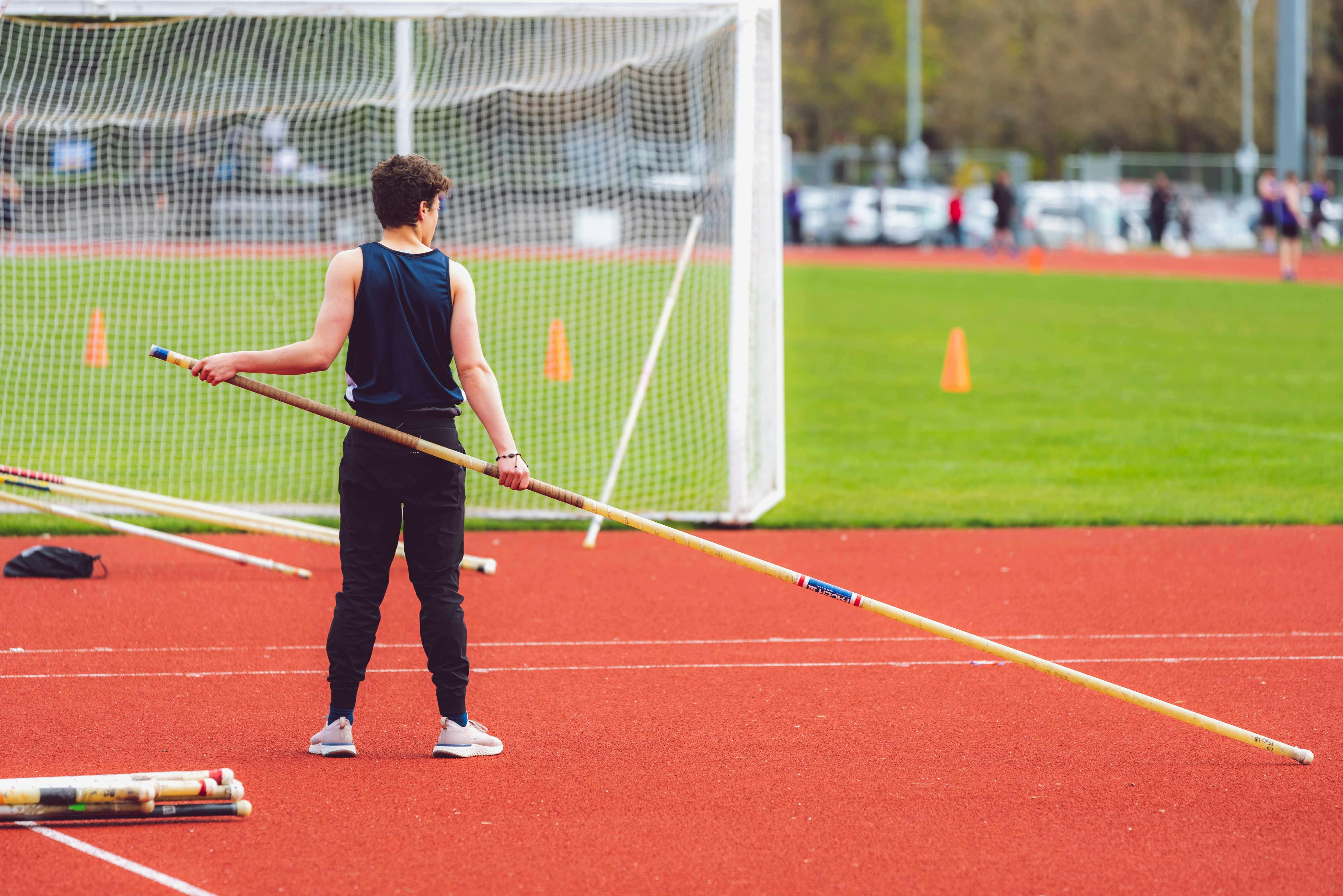Biomechanics of Pole Vaulting: Pushing the Limits of Human Flight
In the realm of track and field, pole vaulting stands as a testament to human ingenuity and physical prowess. This unique event combines speed, strength, and technical skill, challenging athletes to propel themselves skyward using a flexible pole. As vaulters continue to push the boundaries of what's possible, the science behind this captivating sport becomes increasingly crucial. Let's delve into the intricate biomechanics that make pole vaulting a true marvel of athletic achievement.

The Run-Up: Building Kinetic Energy
The pole vault begins long before the athlete leaves the ground. The approach run is a critical phase that sets the foundation for a successful vault. Typically spanning 30-40 meters, this sprint is not just about speed, but about precision and consistency. Vaulters must maintain a specific stride pattern to ensure they hit their takeoff mark accurately.
During the run-up, athletes gradually accelerate, reaching speeds of up to 10 meters per second. This velocity translates into kinetic energy, which will later be converted into potential energy as the vaulter ascends. Biomechanical studies have shown that the final few strides are crucial, with vaulters slightly lowering their center of mass to prepare for the plant phase.
The pole carry technique during the run-up is also essential. Athletes must balance the pole while maintaining sprint mechanics, a skill that requires years of practice. The pole is typically held at an angle, with the tip slightly elevated to reduce air resistance and prepare for the plant.
The Plant and Take-Off: A Moment of Transformation
As the vaulter approaches the box, they enter the most critical phase of the jump: the plant and take-off. This split-second action involves planting the pole into the box while simultaneously driving the take-off foot into the ground. The timing and coordination of this movement are paramount, as it determines the success of the entire vault.
Biomechanically, the plant phase is a complex interaction of forces. As the pole is planted, it begins to bend, storing elastic energy. Simultaneously, the vaulter’s body experiences a rapid deceleration, with ground reaction forces peaking at several times the athlete’s body weight. This abrupt change in velocity creates a whip-like effect, initiating the pole’s bend.
The take-off angle is crucial, typically ranging between 15-20 degrees from vertical. This angle allows for optimal energy transfer from the run-up to the vault while minimizing energy loss. Vaulters must also maintain a straight body position during take-off, aligning their center of mass with the pole to maximize efficiency.
The Swing and Extension: Harnessing Elastic Energy
As the vaulter leaves the ground, they enter the swing phase. Here, the bent pole begins to recoil, releasing its stored elastic energy. The athlete must time their actions perfectly to harness this energy and convert it into vertical momentum.
During the swing, vaulters perform a series of complex movements. They first rock back, creating a C-shaped position with their body. This action helps to further bend the pole and store additional energy. As the pole straightens, the vaulter swings their legs forward and upward, initiating a powerful hip flexion.
The extension phase follows, where the vaulter straightens their body, pushing against the pole to gain additional height. This action is similar to a giant swing in gymnastics, requiring immense core strength and body control. Biomechanical analysis shows that the most successful vaulters can generate angular velocities of up to 200 degrees per second during this phase.
The Turn and Fly-Away: Defying Gravity
As the vaulter reaches the peak of their ascent, they enter the turn and fly-away phase. This is where the athlete must transition from a vertical position to clearing the bar horizontally. The biomechanics of this phase are particularly fascinating, as vaulters must manipulate their body’s moment of inertia to rotate efficiently.
The turn begins as the vaulter reaches full extension. They initiate a twisting motion, rotating their body to face the bar. This action is facilitated by the angular momentum generated during the swing and extension phases. Elite vaulters can complete this rotation in a fraction of a second, demonstrating remarkable spatial awareness and body control.
During the fly-away, the vaulter arches their back to clear the bar, creating a shape similar to the Fosbury Flop in high jumping. This technique maximizes clearance height by allowing the athlete’s center of mass to pass under the bar while their body passes over it. The timing of the push-off from the pole is critical, as pushing too early or too late can result in a failed attempt.
Biomechanical Optimization and Training
Understanding the biomechanics of pole vaulting has revolutionized training methods and equipment design. Coaches now use high-speed video analysis and force plate measurements to fine-tune each phase of the vault. This data-driven approach allows for personalized technique adjustments and targeted strength training.
One area of focus is the development of pole stiffness and grip height. Biomechanical models have shown that using a stiffer pole and a higher grip can lead to greater vault heights, but only if the athlete has the strength and technique to handle these changes. Training programs now incorporate specific exercises to enhance the vaulter’s ability to transfer energy to the pole and maintain body position during the swing.
Another key aspect of biomechanical optimization is injury prevention. The extreme forces experienced during pole vaulting can lead to various injuries, particularly to the shoulder and lower back. By analyzing the stress patterns during each phase of the vault, researchers have developed targeted strengthening exercises and technique modifications to reduce injury risk.
Advancements in pole technology have also been driven by biomechanical research. Modern poles are made from sophisticated composite materials that offer an optimal balance of stiffness and flexibility. The pole’s behavior under load is now carefully engineered to match the biomechanical capabilities of elite vaulters, allowing for higher and more consistent jumps.
The Future of Pole Vault Biomechanics
As technology continues to advance, the future of pole vault biomechanics looks promising. Wearable sensors and artificial intelligence are beginning to provide real-time feedback to athletes and coaches, allowing for immediate technique adjustments. These tools can analyze factors such as approach velocity, take-off angle, and pole bend with unprecedented precision.
Virtual reality simulations are also emerging as a valuable training tool. By creating immersive environments that replicate the biomechanical demands of pole vaulting, athletes can practice their technique in a safe and controlled setting. This technology allows for countless repetitions without the physical wear and tear of traditional training methods.
Genetic analysis is another frontier in pole vault biomechanics. Researchers are exploring how genetic factors influence an athlete’s ability to generate power, maintain body control, and adapt to training. This knowledge could lead to more personalized training programs that maximize each vaulter’s genetic potential.
The pursuit of new world records will likely drive further innovations in pole vault biomechanics. As athletes approach the theoretical limits of human performance, even minor improvements in technique or equipment can make the difference between success and failure. Biomechanical analysis will play a crucial role in identifying these marginal gains and pushing the boundaries of what’s possible in pole vaulting.
Integrating Biomechanics with Other Disciplines
The study of pole vault biomechanics doesn’t exist in isolation. It intersects with various other scientific disciplines, creating a holistic approach to understanding and improving athletic performance. Psychology, for instance, plays a significant role in a vaulter’s ability to execute complex biomechanical sequences under pressure. Mental rehearsal techniques, informed by biomechanical models, can help athletes internalize the perfect vault and reproduce it consistently in competition.
Nutrition science also interfaces with biomechanics, as an athlete’s diet can significantly impact their power output and body composition. Optimal nutrition strategies can enhance a vaulter’s strength-to-weight ratio, a critical factor in achieving greater heights. Similarly, sleep science is becoming increasingly important, as proper rest and recovery are essential for maintaining the precise motor control required for elite pole vaulting.
Aerodynamics is another field that intersects with pole vault biomechanics, particularly during the fly-away phase. Wind tunnel tests and computational fluid dynamics simulations are being used to study how vaulters can minimize air resistance and maximize their time in the air. This research has led to insights on optimal body positioning and even influenced the design of competition uniforms.
The Role of Biomechanics in Coaching and Skill Acquisition
Biomechanical analysis has transformed the way pole vault is coached and learned. Traditional coaching methods relied heavily on subjective observations and the coach’s personal experience. While these remain valuable, they are now supplemented by objective biomechanical data that can identify subtle technique flaws invisible to the naked eye.
Modern coaching incorporates biomechanical principles into every aspect of skill acquisition. Novice vaulters are taught the fundamental movements with a clear understanding of the underlying physics. This approach accelerates the learning process and helps athletes develop a more intuitive feel for the complex interactions between their body and the pole.
Advanced biomechanical modeling also allows coaches to project an athlete’s potential performance based on their physical attributes and technique. This can help in talent identification and long-term athlete development, ensuring that promising vaulters receive appropriate guidance from an early stage.
Ethical Considerations in Biomechanical Enhancement
As biomechanical research continues to push the boundaries of human performance, ethical questions arise. The line between performance optimization and unfair advantage can become blurred. For instance, the development of more advanced pole materials or grip technologies may provide benefits that are not equally accessible to all athletes.
Sports governing bodies must grapple with these issues, balancing the desire for progress with the need to maintain a level playing field. Biomechanical experts often play a crucial role in these discussions, providing scientific insight to inform policy decisions on equipment regulations and competition rules.
There’s also the broader question of how far we should push human limits in pursuit of athletic achievement. As our understanding of biomechanics allows athletes to approach the theoretical maximum of pole vault performance, we must consider the long-term health implications and the spirit of the sport itself.
Biomechanics and Inclusivity in Pole Vaulting
The application of biomechanical principles is also expanding the accessibility of pole vaulting to a wider range of athletes. Adaptive techniques and equipment modifications based on biomechanical research are allowing para-athletes to participate in pole vaulting, showcasing the sport’s potential for inclusivity.
For athletes with different physical capabilities, biomechanical analysis helps in developing customized techniques that maximize their strengths. This might involve adjustments to the run-up, plant, or swing phases to accommodate varying levels of mobility or strength. Such adaptations not only make the sport more inclusive but also push the boundaries of what’s possible in pole vaulting, potentially leading to innovations that benefit all athletes.
The Intersection of Biomechanics and Sports Medicine
The relationship between pole vault biomechanics and sports medicine is increasingly symbiotic. Biomechanical insights inform injury prevention strategies and rehabilitation protocols, while medical advancements allow athletes to recover more quickly and effectively from the physical demands of the sport.
Sophisticated imaging techniques, such as 3D motion capture combined with MRI scans, provide a comprehensive view of how an athlete’s body responds to the forces involved in pole vaulting. This information is invaluable for identifying potential injury risks and developing targeted strengthening programs.
Moreover, biomechanical analysis is crucial in the return-to-sport process after an injury. By comparing an athlete’s movement patterns before and after rehabilitation, medical professionals and coaches can ensure that the vaulter has regained the necessary strength, flexibility, and coordination to compete safely.
Conclusion: The Ongoing Evolution of Pole Vault Biomechanics
The biomechanics of pole vaulting represents a fascinating intersection of physics, physiology, and athletic skill. As our understanding of these complex interactions deepens, we continue to witness remarkable achievements in the sport. From the initial run-up to the final clearance of the bar, every phase of the pole vault is a testament to the human body’s incredible capabilities when pushed to its limits.
The future of pole vault biomechanics promises even greater insights and innovations. As technology advances and our analytical tools become more sophisticated, we may uncover new techniques or training methods that redefine what’s possible in this unique event. The pursuit of new heights in pole vaulting will undoubtedly continue to inspire athletes, scientists, and spectators alike, pushing the boundaries of human performance and our understanding of the remarkable biomechanics behind this captivating sport.





